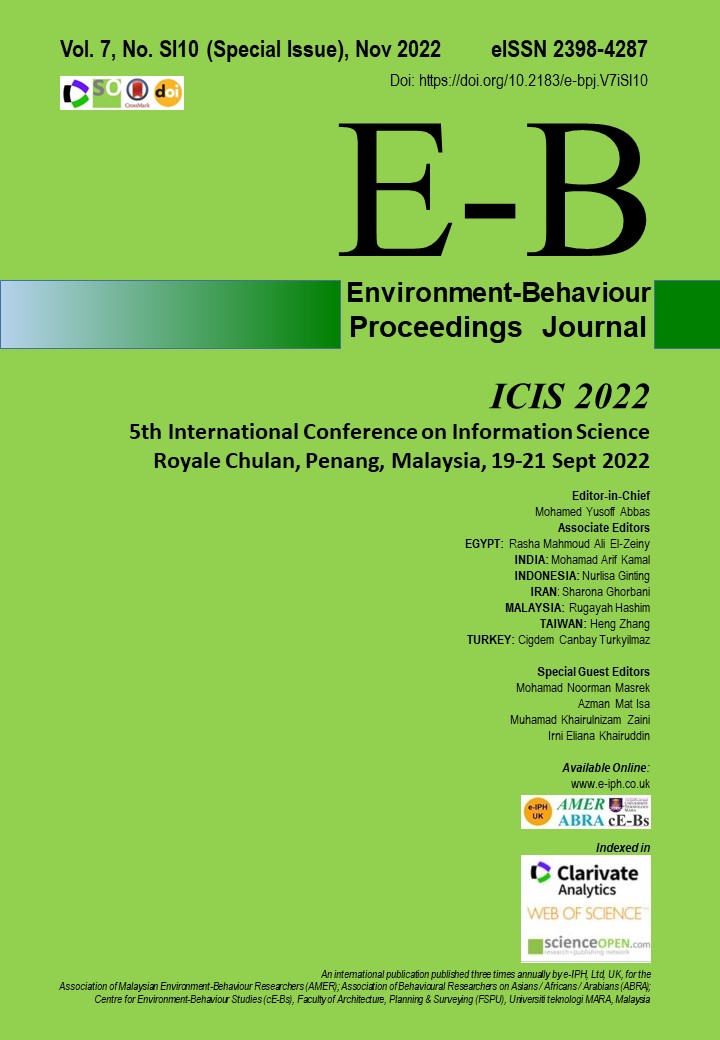Systematic Literature Review: Information security behaviour on smartphone users
DOI:
https://doi.org/10.21834/ebpj.v7iSI10.4133Keywords:
Literature review, Smartphone User, Information Security, Security Behaviour , Literature ReviewAbstract
Information such as bank access, password, and location data stored in the smartphone has become the primary target for cybercriminals. As the users are frequently stated as the weakest link in the information security chain, therefore, there is a need to investigate users' security behavior in the smartphone context. Using the systematic literature review approach, a total of 48 research articles were analyzed to summarizes the developments of Information Security literature on smartphone users. The findings suggest, Qualitative Approach are most adopted approach and Protection Motivation Theory is the most adopted theory in this field.
References
Abraham, S., & Chengalur-Smith, I. (2019). Evaluating the effectiveness of learner-controlled information security training. Computers & Security, 87, 101586.
Alohali, M., Clarke, N., Furnell, S., & Albakri, S. (2017, July). Information security behavior: Recognizing the influencers. In 2017 Computing Conference (pp. 844-853). IEEE.
Breitinger, F., Tully-Doyle, R., & Hassenfeldt, C. (2020). A survey on smartphone user’s security choices, awareness and education. Computers and Security, 88. https://doi.org/10.1016/j.cose.2019.101647
Butler, R. (2021). A systematic literature review of the factors affecting smartphone user threat avoidance behavior. November. https://doi.org/10.1108/ICS-01-2020-0016
Chow, G. W., & Jones, A. (2008). A framework for anomaly detection in OKL4-linux based smartphones. Proceedings of 6th Australian Information Security Management Conference, December 2006, 40–47. https://doi.org/10.4225/75/57b55ad8b876b
Creswell, J. W. (2014). Qualitative, quantitative and mixed methods approaches.
Enge, E. (2021, March 23). Mobile vs. desktop usage in 2020 . perficient.com. Retrieved June 24, 2022, from https://www.perficient.com/insights/research-hub/mobile-vs- desktop-usage
Frické, M. (2009). The knowledge pyramid: a critique of the DIKW hierarchy. Journal of information science, 35(2), 131-142.
Hadlington, L., & Chivers, S. (2021). Segmentation analysis of susceptibility to cybercrime: Exploring individual differences in information security awareness and personality factors. Policing (Oxford), 14(2), 479–492. https://doi.org/10.1093/police/pay027
Hassan, N. H., Ismail, Z., & Maarop, N. (2015). Information Security Culture: A Systematic Literature Revier. Proceedings of the 5th International Conference on Computing and Informatics, ICOCI 2015, 205, 456–463.
Kaspersky. (2022). IT threat evolution in Q1 2022. Non-mobile statistics. Securelist.com. Retrieved June 24, 2022, from https://securelist.com/it-threat-evolution-in-q1-2022-non-mobilestatistics/106531/#:~:text=According%20to%20Kaspersky%20Security%20Network,313%2C164%2C030%20unique%20URLs%20as%20malicious
Kerlinger, F. N. (1979). Behavioral research a conceptual approach.
Li, W., Wang, Y., Li, J., & Xiang, Y. (2020). Toward supervised shape-based behavioral authentication on smartphones. Journal of Information Security and Applications, 55(August), 102591. https://doi.org/10.1016/j.jisa.2020.102591
Lima, A., Sousa, B., Cruz, T., & Simões, P. (2017). Security for mobile device assets: A survey. Proceedings of the 12th International Conference on Cyber Warfare and Security, ICCWS 2017, May, 227–236.
Madyatmadja, E. D., Meyliana, & Prabowo, H. (2016). Participation to public e-service development: A systematic literature review. Journal of Telecommunication, Electronic and Computer Engineering, 8(3), 139–143.
McCusker, K., & Gunaydin, S. (2015). Research using qualitative, quantitative or mixed methods and choice based on the research. Perfusion, 30(7), 537-542.
McGill, T., & Thompson, N. (2018). Gender differences in information security perceptions and behaviour. ACIS 2018 - 29th Australasian Conference on Information Systems, 1–11. https://doi.org/10.5130/acis2018.com
Melinat, P., Kreuzkam, T., & Stamer, D. (2014, September). Information overload: a systematic literature review. In International Conference on Business Informatics Research (pp. 72-86). Springer, Cham.
Mi, T., Gou, M., Zhou, G., Gan, Y., & Schwarzer, R. (2020). Effects of planning and action control on smartphone security behavior. Computers and Security, 97, 101954. https://doi.org/10.1016/j.cose.2020.101954
Mou, J., Cohen, J., Bhattacherjee, A., & Kim, J. (2022). A Test of Protection Motivation Theory in the Information Security Literature : A Meta-Analytic Structural Equation Modeling Approach. 23, 196–236. https://doi.org/10.17705/1jais.00723
Nowrin, S., & Bawden, D. (2018). Information security behaviour of smartphone users: An empirical study on the students of university of Dhaka, Bangladesh. Information and Learning Science, 119(7–8), 444–455. https://doi.org/10.1108/ILS-04-2018-0029
Qadir, S., & Quadri, S. M. K. (2016). Information availability: An insight into the most important attribute of information security. Journal of Information Security, 7(3), 185- 194.
Solomon, A., Michaelshvili, M., Bitton, R., Shapira, B., Rokach, L., Puzis, R., & Shabtai, A. (2022). Contextual security awareness: A context-based approach for assessing the security awareness of users. Knowledge-Based Systems, 246, 108709. https://doi.org/10.1016/j.knosys.2022.108709
Verkijika, S. F. (2018). Understanding smartphone security behaviors: An extension of the protection motivation theory with anticipated regret. Computers and Security, 77, 860–870. https://doi.org/10.1016/j.cose.2018.03.008
Verkijika, S. F. (2019). “If you know what to do, will you take action to avoid mobile phishing attacks”: Self-efficacy, anticipated regret, and gender. Computers in Human Behavior, 101(January), 286–296. https://doi.org/10.1016/j.chb.2019.07.034
Xiao, Q. (2021). Understanding the asymmetric perceptions of smartphone security from security feature perspective: A comparative study. Telematics and Informatics, 58(May 2020), 101535. https://doi.org/10.1016/j.tele.2020.101535
Downloads
Published
How to Cite
Issue
Section
License
Copyright (c) 2022 Ferdinand Jilan Dawie, Mohamad Noorman Masrek, Safawi Abdul Rahman

This work is licensed under a Creative Commons Attribution-NonCommercial-NoDerivatives 4.0 International License.





